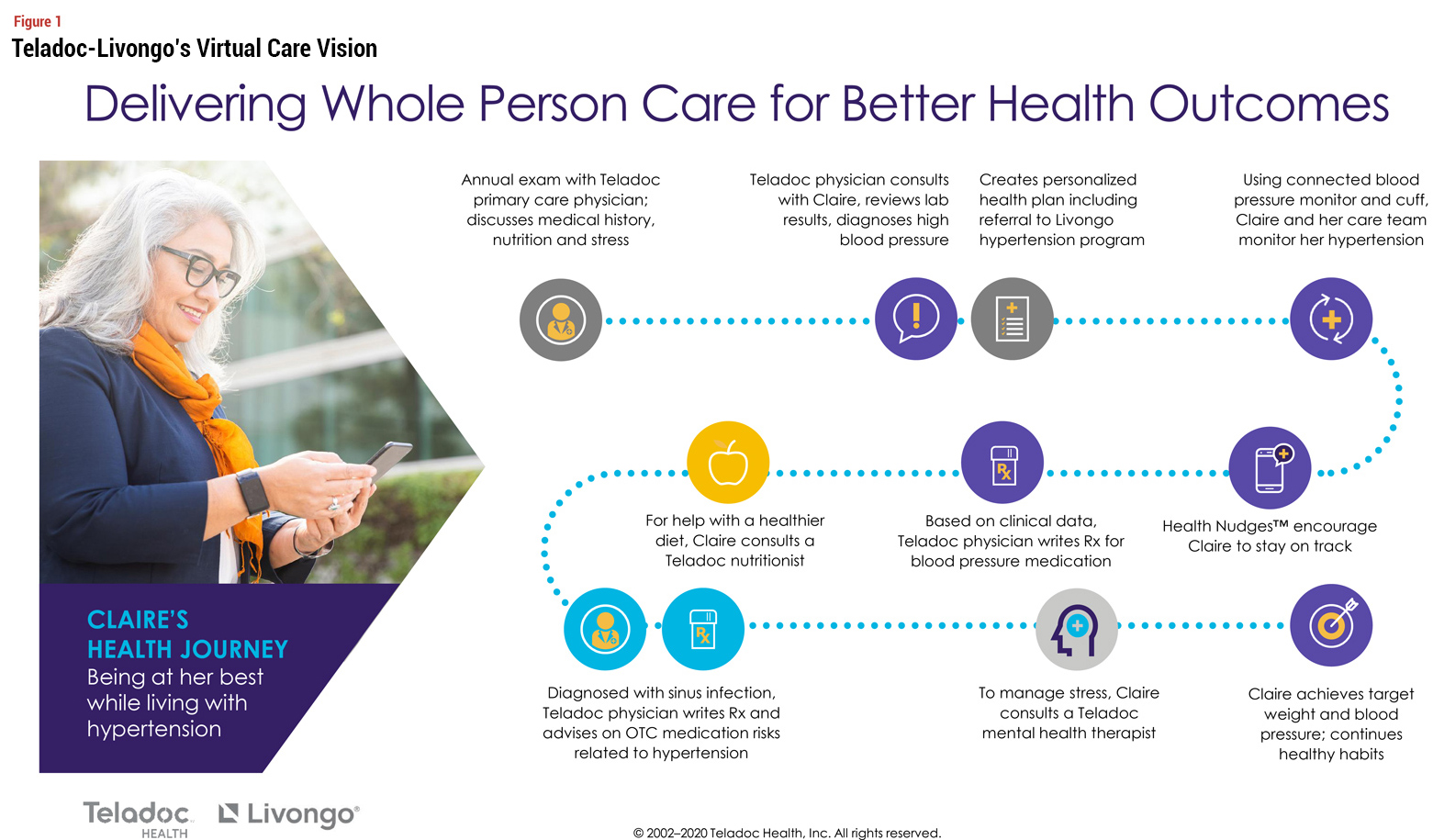ARTICLE SUMMARY:
In August, Telehealth provider Teladoc announced plans to merge with remote chronic care company Livongo, creating a digital health heavyweight with widespread implications for the US virtual care industry.
For companies in the telehealth and remote monitoring markets, the pandemic-driven push to embrace virtual care models is nothing short of a game-changer. Teladoc Health Inc., one of the largest public traded telehealth providers, reported in late July that it facilitated 2.8 million virtual doctor visits in Q2 2020, which is more than triple the number of visits during Q2 2019.
Revenue in the quarter increased 85% year/year to $241 million, which beat Wall Street expectations, and paid US memberships nearly doubled compared to the previous year. The company, which says its telehealth visits have now stabilized at a level that is about 40% higher than pre-COVID numbers, substantially raised its full-year 2020 guidance to between $980 million and $995 million, and said it expects revenue growth of 30% to 40% in 2021.
Although Teladoc, which went public in 2015, is not yet profitable, its strong revenue position has put the company on an acquisition roll, boosting an otherwise declining five-year M&A trend in the digital health space overall.
In early August, Teladoc acquired hospital and health system telehealth provider InTouch Health for $600 million, a move designed to boost Teladoc’s provider-based services. That acquisition was quickly followed by an $18.5 billion stock and cash megadeal, announced on August 5, to acquire Livongo Health Inc., a leading provider of home-based monitoring services for diabetes and other chronic care patients. Under terms of the deal, Teladoc will pay $158.98 per Livongo share in stock and cash, a 10% premium to Livongo’s prior close. The transaction is expected to close by the end of the year, producing a digital health powerhouse with combined 2020 pro forma revenues of more than $1.3 billion.
Founded in 2008, Livongo offers users a suite of digital smart devices and AI-enabled data analysis/patient feedback tools, along with 24/7 support services, to enable people with chronic conditions—including diabetes, obesity, hypertension, and behavioral health issues—to better manage their health.
The company was one of a handful of digital health firms that went public in 2019. And, after a tepid performance in the aftermarket last year, Livongo has benefitted greatly as virtual care models took hold this spring. Livongo’s share price soared 200% in 1H 2020, making the company the top performer thus far among the digital health IPO class of 2019/2020, according to Healthcare Growth Partners.
Thus far, 2020 has been a stellar year for Livongo, which has seen growing demand for its remote care offerings. The company reported revenues of $160.8 million in 1H 2020, up 120% year/year, and a net loss of $7.1 million, which is a substantial improvement over 1H 2019 (Livongo recorded a net loss of $27.3 million in 1H 2019). According to the company, as of June, it had contracts with 1,328 clients (including 30% of Fortune 500 companies and four out of seven of the largest health plans), with more than 410,000 patients enrolled in its flagship diabetes program.
 During a conference call with analysts, company executives called the merger a “transformative event” that will “set the standard for the next generation of virtual care,” creating a company with a “depth and breadth of services unmatched in the digital health space.” The combined entity will have a “significant competitive advantage” in the digital health market, they said, and will have the ability to realize substantial revenue growth synergies through cross-selling, improved member engagement, and further expansion into international markets. Revenue synergies are expected to total $100 million by the end of year two and up to $500 million by 2025, and revenue growth for the combined company, exclusive of those synergies, is expected to be in the 30%-40% range over the next two to three years.
During a conference call with analysts, company executives called the merger a “transformative event” that will “set the standard for the next generation of virtual care,” creating a company with a “depth and breadth of services unmatched in the digital health space.” The combined entity will have a “significant competitive advantage” in the digital health market, they said, and will have the ability to realize substantial revenue growth synergies through cross-selling, improved member engagement, and further expansion into international markets. Revenue synergies are expected to total $100 million by the end of year two and up to $500 million by 2025, and revenue growth for the combined company, exclusive of those synergies, is expected to be in the 30%-40% range over the next two to three years.
The combined company has the potential to offer patients and providers a complete end-to-end virtual care solution that can be more seamlessly integrated into the existing care delivery paradigm. Teladoc and Livongo currently have only about a 25% client overlap, so there is plenty of room to bring in new patients and customers on both sides.
As David Larsen of Verity Research pointed out, although the multiple Teladoc agreed to pay for Livongo may seem high, the cross-selling potential is strong, and the demand for virtual care “robust.”
The end result could strike fear into the hearts of direct competitors in this field. As Stephanie Davis of SVB Leerink notes, “Our feedback from telehealth peers and industry participants suggests this creates a ferocious competitor that will be difficult to outmaneuver.” Davis and others also believe the fallout could precipitate an uptick in me-too M&A in the telemedicine and chronic care markets; Davis mentions private telehealth companies Amwell, MDLive, and Doctor on Demand, as well as Dario Health and Omada Health in the chronic care market, as companies to watch in the coming months.
![]() Trial MyStrategist.com and unlock 7-days of exclusive subscriber-only access to the medical device industry's most trusted strategic publications: MedTech Strategist & Market Pathways. For more information on our demographics and current readership click here.
Trial MyStrategist.com and unlock 7-days of exclusive subscriber-only access to the medical device industry's most trusted strategic publications: MedTech Strategist & Market Pathways. For more information on our demographics and current readership click here.
*End of story*
